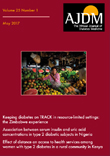Effects of diabetes on human foot
*Corresponding Author:
Received: 29-Dec-2021, Manuscript No. ajdm-22-57470; Accepted Date: Jan 27, 2022 ; Editor assigned: 31-Dec-2021, Pre QC No. ajdm-22-57470 (PQ); Reviewed: 14-Jan-2022, QC No. ajdm-22-57470; Revised: 21-Jan-2022, Manuscript No. ajdm-22-57470 (R); Published: 31-Jan-2022
Editorial
Diabetes is the most common condition prevailing among people which results in high levels of glucose in blood. The complex food that is consumed is digested and converted to glucose in blood which in return produces energy that is required for the body. The absorption of glucose in the human cells is aided by insulin hormone. Lack of insulin production in the body is a sign of type 1 diabetes whereas the utilization of insulin in the body is improper in type 2 diabetes. Lack of adequate insulin leads insufficient supply of Glucose to body cells. Thereby shooting up of glucose levels in blood is occurred. Itching, redness, and cracking are all symptoms of athlete’s foot, which is caused by a fungus. Athlete’s foot is treated with medications like lotions for topical application or tablets to destroy the fungus. Diabetic neuropathy is a type of nerve degeneration that causes tingling, discomfort, and loss of sensation in the foot. Therefore stones in sock cause foot blisters turn into wounds and sores or cuts which gradually get infected if ignored. If the affected parts of leg like foot and toe with foot ulcer don’t get better by treatments, they need to be removed to avoid further spread of infection to other parts of the body. As the diabetic patients are easily prone to heavy infections and gangrene. In order to avoid further complications in the body proper foot care is essential for all diabetic patients.1-5 More than 15% of diabetic people are prone to diabetic foot ulcers under their foot among which 6% of people who are suffering with foot ulcer will come to hospitals for treatment of infections and other ulcer induced health problems. Nearly 24% of the diabetic population are suffering with foot ulcers and the diabetes disease is being one of the biggest causes for amputating parts of legs around the world, but the foot ulcer can be prevented by being cautious with foot and severity can be avoided by taking few precautions. In some people with nerve damage have numbness, tingling, or pain, while others have no symptoms. Nerve damage can also reduce your ability to feel pain, fever, or cold. Painless life sounds pretty good, but it’s expensive. Pain is a way of the body to tell you something is wrong so that you can take care of yourself. If you do not feel pain in your feet, you may not notice cuts, blisters, pain, or other problems. If not treated early, small problems can become serious. Foot ulcers are a typical intricacy of diabetes that isn’t being overseen through techniques like eating regimen, exercise, and insulin treatment. These ulcers always remain unnoticed in the bottom side of toes and feet, but these ignored foot sores can gradually affect the foot and damage the tissue till the infection reach the bone tissue.6-10 The treatments for diabetic foot ulcers keep fluctuating depending upon the causes of the problem. If a person is diabetic and witness any basic infection in foot or toes, it should be immediately taken to notice of doctor to avoid further problems.
Acknowledgement
None
Conflict of Interest
The author has nothing to disclose and also state no conflict of interest in the submission of this manuscript.
References
- Stiegler H. Das diabetische Fußsyndrom. Herz. 2004; 29 (1): 104–15
- Formosa C, Gatt A, Chockalingam N. A critical evaluation of existing diabetic foot screening guidelines. Rev Diabet Stud. 2016; 13(2-3): 158
[Cross Ref] [Google Scholar] [PubMed]
- Al-Hamead HA, Al-Metwally RI, Khaled MA, et al. Bacteriological study of diabetic foot infection in Egypt. J Arab Soc Med Res. 2019; 8 (1): 26–32
[Cross Ref] [Google Scholar] [PubMed]
- Darlington C, Kumar S, Jagdish S, et al. Evaluation of Serum Vitamin D Levels in Diabetic Foot Infections: A Cross-Sectional Study in a Tertiary Care Center in South India. Iran J Med Sci. 2019; 44(6): 474-482
- Marson BA, Deshmukh SR, Grindlay DJC, et al. A systematic review of local antibiotic devices used to improve wound healing following the surgical management of foot infections in diabetics. Bone Joint J. 2018;100-B (11): 1409–1415
- Dumville JC, O'Meara S, Deshpande S, et al. Hydrogel dressings for healing diabetic foot ulcers. Cochrane Database Syst Rev. 2013;7(7): CD009101
- Mallik BS, Jayashree BS, Shenoy RR. Epigenetic modulation of macrophage polarization- perspectives in diabetic wounds. J Diabetes Complications. 2018; 32(5): 524–530
- Aoife H, Roozbeh N, Nachiappan C. The Effectiveness of Footwear and Other Removable Off-loading Devices in the Treatment of Diabetic Foot Ulcers: A Systematic Review. Curr Diabetes Rev. 2014;10(4):215–230
- Litzelman DK, Slemenda CW, Langefeld CD, et al. Reduction of lower extremity clinical abnormalities in patients with non-insulin-dependent diabetes mellitus. A randomized, controlled trial. Ann Intern Med. 1993;119(1):36–41
- Duda DG, Fukumura D, Jain RK. Role of eNOS in neovascularization: NO for endothelial progenitor cells. Trends Mol Med. 2004;10(4):143–5





